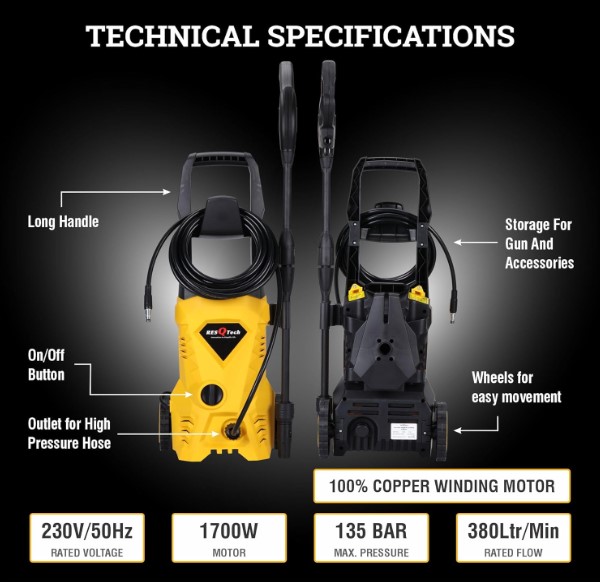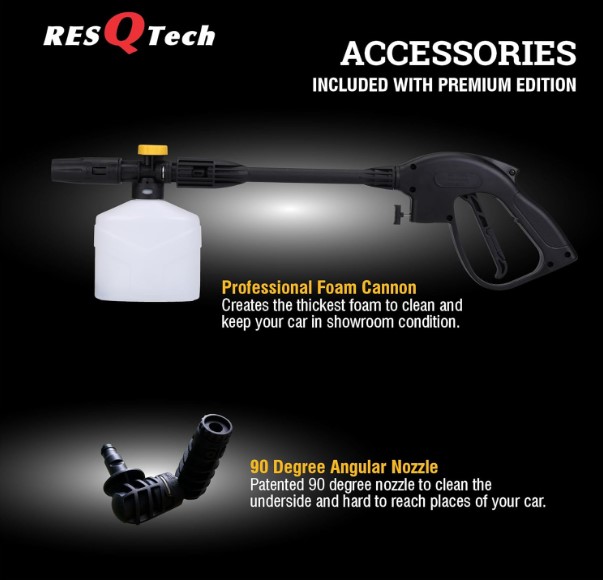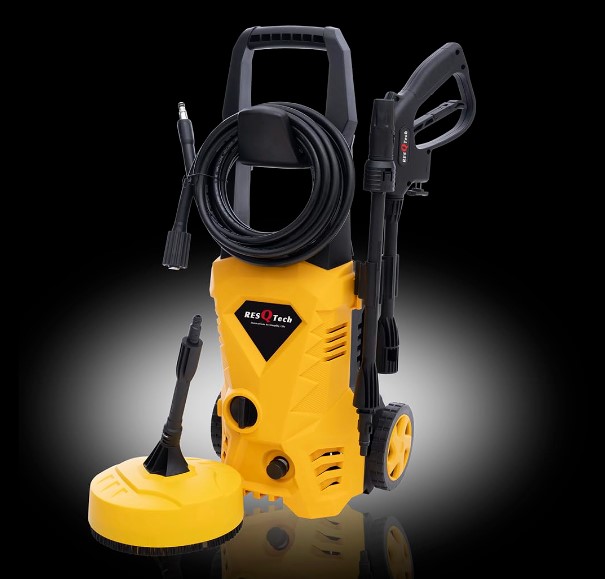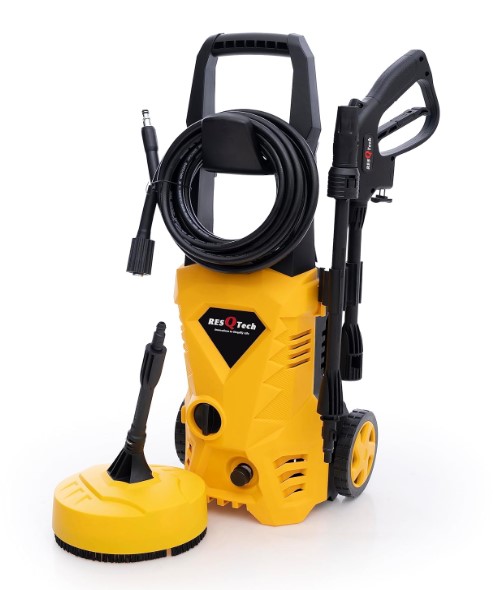A pressure washer is a powerful cleaning machine that uses high-pressure water to remove stubborn dirt, grime, and other unwanted materials from various surfaces. It is a versatile tool that can be used for a wide range of cleaning tasks, from washing cars and decks to removing graffiti and cleaning industrial equipment.
Pressure washers work by forcing water through a small nozzle at extremely high pressure, typically ranging from 1,000 to 4,000 pounds per square inch (PSI). This concentrated stream of water can effectively blast away dirt, grease, and other contaminants that would be difficult to remove with traditional cleaning methods.
The basic components of a pressure washer include:
- Motor or Engine: This provides the power to drive the pump, which can be electric or gasoline-powered.
- Pump: The pump is responsible for building up the high pressure by forcing water through a small nozzle.
- High-Pressure Hose: This hose connects the pump to the spray wand and is designed to withstand the high pressures generated by the pump.
- Spray Wand and Nozzle: The spray wand is the handheld component that allows the user to direct the high-pressure water stream, while the nozzle at the end determines the spray pattern and pressure.
There are two main types of pressure washers: residential/consumer-grade and commercial/industrial-grade. Residential pressure washers are typically less powerful, with pressure ratings between 1,000 and 3,000 PSI, and are designed for homeowner use. Commercial pressure washers, on the other hand, are more powerful, with pressure ratings up to 4,000 PSI or higher, and are built for heavy-duty cleaning tasks in industrial or commercial settings.
Table of Contents
How Does a Pressure Washer Work?
A pressure washer is a powerful cleaning machine that utilizes high-pressure water to remove stubborn dirt, grime, and other unwanted materials from various surfaces. The mechanism behind a pressure washer’s operation is relatively simple but highly effective.
At the heart of a pressure washer lies a pump, which is responsible for generating the high-pressure water stream. This pump draws in water from a source, such as a garden hose or a built-in tank, and forces it through a narrow opening or nozzle. As the water is compressed and pushed through the nozzle, its pressure increases significantly, creating a powerful, concentrated stream.
The water pressure generated by a pressure washer can range from around 1,000 pounds per square inch (PSI) for light-duty residential models to over 4,000 PSI for heavy-duty commercial and industrial units. This high-pressure water stream is capable of dislodging and removing even the most stubborn dirt, grime, and debris from surfaces.
Pressure washers typically feature interchangeable nozzles, each designed for specific cleaning tasks. These nozzles vary in their spray pattern and water flow rate, allowing users to adjust the pressure and coverage area according to their needs. Common nozzle types include:
- Zero-degree nozzle: This nozzle produces a concentrated, pencil-thin stream of water, ideal for cutting through tough, caked-on grime or removing paint from surfaces.
- 15-degree nozzle: With a slightly wider spray pattern, this nozzle is suitable for cleaning tight spaces or removing stubborn dirt from concrete or masonry surfaces.
- 25-degree nozzle: This nozzle offers a wider fan-shaped spray pattern, making it useful for general cleaning tasks over larger surface areas.
- 40-degree nozzle: With the widest spray pattern, this nozzle is best suited for gentle cleaning or rinsing tasks, as it covers a larger area but with lower pressure.
By understanding the mechanism behind pressure washers and the various nozzle options, users can effectively tackle a wide range of cleaning tasks, from light-duty jobs around the home to heavy-duty industrial applications.

Uses of Pressure Washers
Pressure washers are versatile tools with a wide range of applications for cleaning and maintenance tasks. They are commonly used for the following purposes:
Cleaning Vehicles: Pressure washers effectively remove stubborn dirt, mud, and grime from cars, trucks, boats, and other vehicles. The high-pressure water stream can clean hard-to-reach areas and dislodge caked-on debris, leaving surfaces sparkling clean.
Exterior Building Cleaning: Pressure washers are invaluable for cleaning the exterior of buildings, including siding, brick, concrete, and other surfaces. They can remove mildew, moss, and other buildup, restoring the fresh appearance of buildings and preventing long-term damage caused by neglected maintenance.
Deck and Patio Cleaning: Wooden decks, patios, and outdoor living spaces can accumulate dirt, mold, and stains over time. Pressure washers can effectively clean these surfaces, removing grime and revitalizing the wood or concrete.
Driveway and Sidewalk Cleaning: The powerful water stream from a pressure washer can blast away oil stains, tire marks, and other stubborn grime from driveways, sidewalks, and other paved surfaces, leaving them looking like new.
Industrial Cleaning: In industrial settings, pressure washers are used for heavy-duty cleaning tasks, such as removing grease, oil, and other contaminants from machinery, equipment, and work areas. They are also useful for cleaning large vehicles, like trucks and construction equipment.
Surface Preparation: Pressure washers can effectively prepare surfaces for painting, staining, or sealing by removing loose debris, dirt, and other contaminants, ensuring proper adhesion and a professional finish.
Agricultural Applications: In the agricultural industry, pressure washers are used to clean farm equipment, livestock pens, and other areas, helping to maintain sanitary conditions and prevent the spread of diseases.
With their ability to deliver high-pressure water streams, pressure washers are versatile tools that can tackle a wide range of cleaning tasks, saving time and effort while achieving superior results compared to traditional cleaning methods.
Types of Pressure Washers
Pressure washers come in various types, each designed to cater to specific needs and applications. The primary categories include electric, gas-powered, hot water, cold water, commercial, and residential pressure washers.
Electric Pressure Washers: Electric pressure washers are popular for their convenience, quieter operation, and eco-friendliness. They are typically lightweight and compact, making them ideal for residential use and smaller cleaning tasks. Electric models are available in different power ratings, with lower-end units suitable for light-duty tasks like cleaning patio furniture, while higher-end models can handle more demanding jobs like removing stubborn stains from concrete surfaces.
Gas-Powered Pressure Washers: Gas-powered pressure washers are known for their high-pressure output and durability, making them suitable for heavy-duty cleaning tasks. They are powered by gasoline engines, which provide more power than their electric counterparts. These units are often used for industrial and commercial applications, such as cleaning large equipment, buildings, and vehicles. However, they tend to be noisier and produce emissions, which may not be ideal for residential areas.
Hot Water Pressure Washers: Hot water pressure washers use heated water to enhance cleaning power and efficiency. The high-temperature water can effectively remove tough grime, grease, and oil stains from surfaces. These units are commonly used in industries like automotive, food processing, and manufacturing, where heavy-duty cleaning is required. Hot water pressure washers can be powered by electricity or gasoline, depending on the specific model and application.
Cold Water Pressure Washers: Cold water pressure washers are the most common and versatile type, suitable for a wide range of cleaning tasks. They use regular cold water from a garden hose or other water source and are available in both electric and gas-powered models. Cold water pressure washers are typically more affordable and easier to maintain than hot water units, making them a popular choice for residential and light commercial use.
Commercial Pressure Washers: Commercial pressure washers are designed for heavy-duty cleaning tasks in industrial and commercial settings. They are typically gas-powered and offer high pressure and flow rates, allowing for efficient cleaning of large areas and stubborn stains. These units are built to withstand frequent use and harsh environments, with robust construction and durable components.
Residential Pressure Washers: Residential pressure washers are designed for homeowner use and are typically smaller, lighter, and more affordable than commercial units. They are available in both electric and gas-powered models and are suitable for tasks like cleaning decks, siding, driveways, and outdoor furniture. Residential pressure washers offer a balance between power and portability, making them a convenient choice for homeowners.

Choosing the Right Pressure Washer
Selecting the appropriate pressure washer is crucial for ensuring effective cleaning and efficient operation. Several factors should be considered when choosing the right pressure washer for your needs:
Cleaning Task: Determine the types of surfaces and materials you’ll be cleaning. Different pressure washers are designed for specific applications, such as cleaning decks, siding, vehicles, or heavy-duty industrial equipment. Consider the level of grime, dirt, or stains you need to remove.
Power Needs: Pressure washers are rated by their water pressure (measured in pounds per square inch or PSI) and water flow rate (measured in gallons per minute or GPM). Higher PSI and GPM values generally indicate more cleaning power, but excessive pressure can damage certain surfaces. Match the power output to the cleaning task at hand.
Portability: Consider the size, weight, and mobility requirements of the pressure washer. Electric models are typically lighter and more compact, making them ideal for residential use and easy transportation. Gas-powered units are generally more powerful but heavier and less portable.
Budget: Pressure washers range in price from basic residential models costing a few hundred dollars to commercial-grade units that can cost thousands. Determine your budget and prioritize the features that are most important to you, such as power, durability, and additional accessories.
Other factors to consider include the type of power source (electric or gas), the availability of hot water capability (for removing stubborn grime), and the inclusion of additional features like adjustable nozzles, detergent tanks, or hose reel systems. By carefully evaluating your specific needs and requirements, you can choose a pressure washer that delivers optimal cleaning performance while fitting your budget and operational preferences.
Pressure Washer Safety
Pressure washers are powerful tools that can cause severe injury if not used properly. Safety should be the top priority when operating a pressure washer. Here are some essential safety precautions and guidelines:
Personal Protective Equipment (PPE)
- Wear protective eyewear: Pressure washers can dislodge debris, causing eye injuries. Wear safety goggles or a face shield to protect your eyes.
- Wear sturdy footwear: Opt for non-slip, closed-toe shoes or boots to prevent slips and protect your feet from high-pressure water spray.
- Wear protective clothing: Long pants and long-sleeved shirts can help protect your skin from potential injuries caused by the high-pressure water stream.
- Use ear protection: The noise generated by pressure washers can be loud, especially in enclosed spaces. Wear earplugs or earmuffs to prevent hearing damage.
Handling Guidelines
- Never point the wand at people or pets: The high-pressure water stream can cause severe injuries or even penetrate the skin.
- Maintain a safe distance: Keep a reasonable distance from the surface being cleaned to avoid kickback or recoil from the wand.
- Use both hands: Always hold the pressure washer wand with both hands to maintain control and stability.
- Avoid electrical hazards: Keep the pressure washer and all electrical components away from water sources, such as pools or ponds, to prevent electric shocks.
- Be aware of your surroundings: Watch for potential trip hazards, slippery surfaces, or obstacles that could cause you to lose control of the pressure washer.
- Secure loose objects: Ensure that any loose objects in the area are secured or removed to prevent them from becoming projectiles.
- Read the manufacturer’s instructions: Thoroughly review the user manual and follow all safety guidelines provided by the manufacturer.
By adhering to these safety precautions and handling guidelines, you can significantly reduce the risk of accidents and injuries when using a pressure washer. Remember, safety should always be the top priority when operating powerful tools like pressure washers.

Pressure Washer Maintenance
Proper maintenance is crucial for ensuring your pressure washer operates efficiently and lasts for years. Regular cleaning, storage, and troubleshooting can help extend the lifespan of your pressure washer and prevent costly repairs or replacements.
Cleaning:
After each use, it’s essential to clean your pressure washer thoroughly. Start by disconnecting the water supply and releasing any remaining pressure in the system. Next, remove any debris or dirt from the exterior using a damp cloth or brush. Pay special attention to the nozzle, as clogged nozzles can significantly reduce the washer’s performance.
Storage:
Proper storage is essential for preserving your pressure washer’s condition. Before storing, run a mixture of water and pump protector through the system to lubricate the internal components and prevent corrosion. Store the pressure washer in a dry, well-ventilated area, away from direct sunlight and extreme temperatures.
Troubleshooting Common Issues:
Over time, pressure washers may encounter various issues. Here are some common problems and their potential solutions:
- Low Pressure: Low pressure can be caused by a clogged nozzle, a faulty pump, or a leak in the system. Clean or replace the nozzle, check for leaks, and consider servicing the pump if the issue persists.
- Pulsating Pressure: Pulsating pressure often indicates air in the system or a faulty valve. Bleed the air from the system and check the inlet and unloader valves for proper functioning.
- Leaks: Leaks can occur at various points, such as fittings, hoses, or the pump itself. Tighten loose connections, replace worn-out components, and consider servicing the pump if the leak persists.
- Engine Problems: If your pressure washer is powered by an engine, issues like difficulty starting, lack of power, or excessive smoke may indicate problems with the engine itself. Refer to the engine manual for troubleshooting and maintenance guidance.
Extending Lifespan:
To maximize the lifespan of your pressure washer, follow these tips:
- Regular Maintenance: Adhere to the recommended maintenance schedule in the owner’s manual, including changing the oil, air filters, and spark plugs (if applicable).
- Use Appropriate Detergents: Only use detergents specifically designed for pressure washers. Harsh chemicals can damage the pump and other components.
- Winterize: In cold climates, it’s essential to winterize your pressure washer to prevent freeze damage. Follow the manufacturer’s recommendations for proper winterization procedures.
- Protect from Debris: Keep the pressure washer clean and free from debris, as dirt and grime can accelerate wear and tear on various components.
By following these maintenance practices, you can ensure your pressure washer operates at peak performance and extend its lifespan, saving you money and hassle in the long run.
Pressure Washing Techniques
Pressure washing requires proper techniques to ensure efficient cleaning while avoiding damage to surfaces. Here are some best practices and tips for effective pressure washing:
Surface Preparation
Proper surface preparation is crucial for optimal results and preventing potential damage. Begin by clearing the area of any loose debris, dirt, or objects that could become projectiles. If working on a porous surface like concrete, it’s recommended to apply a concrete cleaner or degreaser before pressure washing to help break down stubborn stains and grime.
Nozzle Selection
Different nozzles are designed for specific cleaning tasks. A wider nozzle angle (40-65 degrees) is suitable for general cleaning and covering larger areas, while a narrower angle (0-15 degrees) provides a concentrated stream ideal for removing tough stains or built-up grime. Experiment with different nozzles to find the right balance between cleaning power and surface protection.
Technique and Movement
Maintain a consistent distance of 6-12 inches from the surface, adjusting as needed based on the pressure and surface type. Use a sweeping motion, overlapping each pass by a few inches to ensure complete coverage. Avoid dwelling too long in one spot, as this can etch or damage the surface.
Water Pressure and Flow Rate
Start with a lower pressure setting and gradually increase as needed, considering the surface material and condition. Higher pressure is not always better, as it can cause damage or create a mess. Adjust the water flow rate to achieve the desired cleaning power while minimizing overspray and runoff.
Hot Water vs. Cold Water
Hot water can be more effective for breaking down stubborn grime, grease, and oil stains. However, it may not be necessary for all cleaning tasks and can increase the risk of surface damage or personal injury if not used properly.
Environmentally Friendly Practices
Consider using eco-friendly detergents or biodegradable cleaning solutions to minimize environmental impact. Divert runoff away from storm drains, waterways, or sensitive areas, and dispose of any collected waste properly.
Safety Precautions
Always wear appropriate personal protective equipment, such as goggles, gloves, and closed-toe shoes. Be cautious of kickback from the high-pressure stream and avoid pointing the wand at people, pets, or fragile surfaces. Follow all manufacturer guidelines and safety instructions.
By following these pressure washing techniques and best practices, you can achieve efficient and effective cleaning results while protecting surfaces and minimizing environmental impact.
Pressure Washer Accessories
Pressure washers are versatile tools, but their effectiveness can be enhanced with the right accessories. From surface cleaners to specialized nozzles, hoses, and detergents, the right accessories can make pressure washing tasks more efficient, thorough, and convenient.
Surface Cleaners: Surface cleaners are circular attachments that spin at high speeds, allowing you to clean flat surfaces more quickly and evenly. They are particularly useful for cleaning decks, patios, driveways, and other large, flat areas, as they cover a wider area with each pass.
Nozzles: Different nozzles are designed for specific tasks, allowing you to adjust the water pressure and spray pattern. For example, a rotary nozzle creates a concentrated, rotating stream for tough stains and grime, while a wide-angle nozzle provides a gentler, broader spray for delicate surfaces or rinsing.
Hoses: High-quality, reinforced hoses are essential for pressure washers, as they must withstand the high water pressure without bursting or leaking. Look for hoses with abrasion-resistant coverings and kink-resistant designs for maximum durability and maneuverability.
Detergents: Pressure washer detergents are specially formulated to work with the high-pressure water stream, helping to break down stubborn grime, grease, and stains. Choose detergents designed for specific surfaces, such as concrete, wood, or vehicles, for optimal cleaning results.
Other Accessories: Additional accessories can further enhance your pressure washing experience, such as extension wands for hard-to-reach areas, surface brushes for scrubbing, and water brooms for cleaning tight spaces. Some pressure washers also offer specialized attachments for tasks like cleaning gutters, windows, or vehicles.
By investing in the right accessories, you can tackle a wider range of cleaning tasks with your pressure washer, achieving better results in less time and with less effort. Consider your specific needs and the surfaces you’ll be cleaning to choose the most appropriate accessories for your pressure washing projects.
Environmental Considerations
Pressure washers are powerful tools that use a significant amount of water, making it essential to consider environmental factors when operating them. Water conservation, proper disposal of wastewater, and the use of eco-friendly cleaning solutions are critical aspects to address.
Water Conservation: Pressure washers can consume a substantial amount of water, especially during prolonged use. To minimize water wastage, it’s crucial to use water-saving techniques. Consider using a pressure washer with adjustable flow rates, which allows you to reduce water consumption when cleaning less demanding surfaces. Additionally, avoid letting the water run continuously when not actively cleaning, and use the appropriate nozzle for the task at hand to prevent excessive water usage.
Proper Disposal of Wastewater: The wastewater generated from pressure washing can contain various contaminants, such as detergents, chemicals, and debris. Improper disposal of this wastewater can lead to environmental pollution and harm aquatic life. It’s essential to follow local regulations and guidelines for the proper disposal of wastewater. In some cases, you may need to filter or treat the wastewater before disposing of it safely. Consider using a containment system or directing the wastewater to a designated disposal area to prevent it from entering storm drains or water bodies.
Eco-friendly Cleaning Solutions: Many traditional cleaning solutions used in pressure washing can be harmful to the environment. These solutions may contain toxic chemicals, solvents, or harsh detergents that can pollute water sources and harm plant and animal life. To reduce your environmental impact, consider using eco-friendly, biodegradable cleaning solutions specifically designed for pressure washing. These solutions are typically made from plant-based or natural ingredients and are less harmful to the environment. Additionally, use these solutions sparingly and follow the manufacturer’s instructions for proper dilution and application.
By prioritizing water conservation, proper disposal of wastewater, and the use of eco-friendly cleaning solutions, you can minimize the environmental impact of pressure washing activities. These practices not only protect the environment but also contribute to sustainable practices and responsible resource management.
Pressure Washer Rental vs. Buying
Deciding whether to rent or buy a pressure washer depends on several factors, including cost, frequency of use, project duration, and storage considerations.
Cost Analysis: Renting a pressure washer is generally more economical for one-time or infrequent projects. The rental cost, which typically ranges from $30 to $100 per day, can be significantly lower than purchasing a new unit, especially for high-end models. However, if you plan to use a pressure washer regularly, buying one may be more cost-effective in the long run.
Frequency of Use: If you have a large property or multiple projects that require pressure washing, owning a pressure washer can be more convenient and cost-effective. Frequent renters may end up paying more in rental fees than the cost of purchasing a unit outright.
Project Duration: For short-term projects lasting a day or two, renting a pressure washer is often the preferred choice. However, if your project spans several days or weeks, buying a pressure washer may be more practical and cost-effective than repeated rentals.
Storage Considerations: Owning a pressure washer requires dedicated storage space, which can be a challenge for those with limited space. Renting eliminates the need for storage but requires transporting the unit to and from the rental facility. If you have ample storage space and plan to use the pressure washer regularly, purchasing one may be more convenient.
When making the decision to rent or buy, consider the total cost over the expected lifespan of the pressure washer, factoring in maintenance and repair costs. Additionally, evaluate the availability and convenience of rental options in your area. Ultimately, the choice will depend on your specific needs, budget, and project requirements.
Pressure Washer Brands and Reviews
Pressure washers are available from a wide range of brands, catering to different budgets and needs. Some of the most popular and well-regarded brands in the market include:
Karcher: Karcher is a German brand known for its high-quality and innovative pressure washers. Their products are often praised for their durability, performance, and user-friendly design. Karcher offers a wide range of models for residential and commercial use, from compact electric units to powerful gas-powered machines.
Simpson Cleaning: Simpson Cleaning is an American brand that has been manufacturing pressure washers for over 50 years. Their products are known for their reliability, powerful cleaning capabilities, and robust construction. Simpson offers both residential and commercial-grade pressure washers, with models suitable for various applications.
Sun Joe: Sun Joe is a popular brand for budget-friendly pressure washers. While their products may not match the power and durability of higher-end brands, they offer a good balance of performance and affordability for homeowners and DIYers. Sun Joe’s pressure washers are often praised for their compact size and ease of use.
Generac: Generac is a well-known brand in the power equipment industry, and their pressure washers are no exception. They offer a range of residential and commercial models, including gas-powered and electric units. Generac pressure washers are known for their reliable performance and robust construction.
Customer reviews and professional recommendations play a crucial role in helping consumers make informed decisions when purchasing a pressure washer. Positive reviews often highlight factors such as cleaning power, ease of use, durability, and value for money. Negative reviews may point out issues like poor customer service, frequent breakdowns, or lack of performance.
Professional recommendations from contractors, cleaning companies, and industry experts can also provide valuable insights into the best pressure washer brands and models for specific applications. These recommendations often consider factors such as job site requirements, durability, and long-term cost of ownership.
Ultimately, choosing the right pressure washer brand and model depends on factors such as intended use, budget, and personal preferences. Researching customer reviews and professional recommendations can help narrow down the options and ensure a satisfactory purchase.
DIY Pressure Washing Projects
Pressure washers are invaluable tools for tackling a wide range of home improvement and cleaning projects. With the right pressure washer and a bit of know-how, you can save significant money by doing it yourself instead of hiring professional services. From revitalizing your home’s exterior to deep-cleaning outdoor surfaces, the possibilities are endless.
One of the most common DIY pressure washing projects is cleaning exterior siding, whether it’s vinyl, wood, brick, or stucco. Over time, these surfaces accumulate dirt, grime, and even mildew, which can make your home look dull and neglected. With a pressure washer, you can blast away years of built-up grime, revealing a fresh, like-new appearance. Before and after photos of pressure-washed homes are truly remarkable, showcasing the transformative power of this simple technique.
Pressure washers are also excellent for cleaning driveways, walkways, and patios. These high-traffic areas can become stained and discolored from oil, grease, and other contaminants. A thorough pressure washing can remove these unsightly blemishes, restoring the original color and beauty of your hardscaping. The cost savings compared to professional cleaning services can be substantial, making pressure washing a wise investment for any homeowner.
Other popular DIY pressure washing projects include cleaning decks, fences, and outdoor furniture. These surfaces are constantly exposed to the elements, leading to a buildup of dirt, mildew, and even algae growth. Pressure washing can effectively remove these unwanted guests, leaving your outdoor living spaces looking refreshed and inviting.
Before embarking on any pressure washing project, it’s essential to understand the proper techniques and safety precautions. Start with lower pressure settings and work your way up as needed, being careful not to damage delicate surfaces. Always wear protective gear, such as goggles and closed-toe shoes, and never point the wand directly at people, pets, or fragile objects.
With a little practice and the right pressure washer, you can tackle a wide range of DIY projects, saving money while enhancing the beauty and value of your home. Embrace the power of pressure washing and enjoy the satisfaction of a job well done.
Commercial and Industrial Pressure Washing
Pressure washing finds extensive applications in commercial and industrial settings, where heavy-duty cleaning tasks demand powerful and efficient solutions. In these environments, large-scale pressure washing projects are commonplace, requiring specialized equipment and professional services.
Commercial pressure washing services are crucial for maintaining the appearance and longevity of various structures and surfaces. From office buildings and shopping malls to warehouses and factories, these services help remove built-up grime, graffiti, and other stubborn contaminants that can degrade the appearance and integrity of surfaces over time.
Industrial pressure washing plays a vital role in maintaining the cleanliness and safety of manufacturing facilities, construction sites, and other heavy-duty environments. These applications often involve removing hazardous materials, such as chemical residues, oil, and grease, from machinery, equipment, and work areas. Specialized pressure washing techniques and equipment are employed to ensure thorough cleaning while adhering to strict safety and environmental regulations.
Large-scale commercial and industrial pressure washing projects typically require the use of high-powered, heavy-duty pressure washers capable of delivering water pressures ranging from 3,000 to 10,000 PSI (pounds per square inch). These powerful machines are designed to handle the toughest cleaning challenges and can be equipped with various nozzles and attachments to tackle different surfaces and contaminants effectively.
In addition to the equipment, professional pressure washing services often employ experienced technicians trained in the safe and efficient use of these powerful machines. They possess the knowledge and expertise to assess the specific cleaning requirements of each project and select the appropriate techniques, equipment, and cleaning solutions to achieve optimal results.
Commercial and industrial pressure washing services may also involve the use of specialized cleaning agents and detergents specifically formulated for different applications. These solutions can enhance the cleaning power of the water stream and help break down stubborn contaminants, making the cleaning process more efficient and effective.
Furthermore, many professional pressure washing companies prioritize environmental responsibility by implementing eco-friendly practices. This may include the use of biodegradable cleaning solutions, proper waste disposal methods, and water conservation techniques to minimize the environmental impact of their operations.
Overall, commercial and industrial pressure washing services provide essential solutions for maintaining the cleanliness, safety, and aesthetic appeal of various structures and facilities, ensuring they remain in optimal condition for years to come.
Future of Pressure Washers
The future of pressure washers looks promising, with several technological advancements and eco-friendly innovations on the horizon. As environmental concerns continue to grow, manufacturers are focusing on developing more energy-efficient and environmentally friendly pressure washers.
One significant trend is the development of electric pressure washers powered by lithium-ion batteries. These cordless units eliminate the need for gas or extension cords, making them more portable and convenient for use in various settings. Additionally, they produce zero emissions, making them an eco-friendly choice for residential and commercial applications.
Another area of innovation is the integration of advanced control systems and smart features. Pressure washers may soon incorporate sensors and automated systems that can adjust water pressure, flow rate, and temperature based on the cleaning task at hand. This could lead to more efficient water usage and improved cleaning performance.
Manufacturers are also exploring the use of alternative energy sources, such as solar power, to reduce the environmental impact of pressure washers. Solar-powered pressure washers could potentially operate without relying on traditional energy sources, making them a sustainable choice for outdoor cleaning tasks.
In terms of water conservation, advancements in water recycling and filtration systems are being explored. These systems could allow pressure washers to reuse and recycle water, minimizing water consumption and reducing the environmental impact of pressure washing activities.
Furthermore, the use of eco-friendly detergents and cleaning solutions is expected to become more prevalent. These biodegradable and non-toxic formulations can help minimize the negative impact on the environment while still providing effective cleaning power.
Overall, the future of pressure washers is focused on developing more efficient, eco-friendly, and technologically advanced solutions that cater to the growing demand for sustainable cleaning methods. As environmental awareness continues to rise, these innovations will play a crucial role in shaping the pressure washing industry and promoting responsible cleaning practices.



